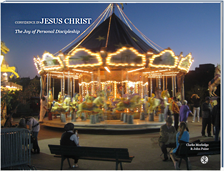Another travelog installment!! … One of the highlights of visiting Cambridge, England around Christmas this past year was the opportunity to visit places that I could really geek out about. Readers of the Veracity blog will know that my two favorite topics to think about are church history and Christian apologetics. You have both topics in abundance to visit and consider in Cambridge, England.
Venturing across “the Backs” behind Queens College in Cambridge to find a few places in particular was an adventure. The rains had swollen the Cam River, but I was able to get a nice view of the “Mathematical Bridge” behind Queens College. It was a popular fable that Sir Isaac Newton had built this bridge, but actually it was a William Etheridge and a James Essex who originally built this unique structure, with lots of mathematical engineering involved, in 1749.

The Mathematical Bridge crossing the Cam River, behind Queens College in Cambridge, England. It was a dreary day in Cambridge when I took this photo, though the sun poked out a couple of times.
So, what is the church history connection with Queens College in Cambridge? Well, it was where Desiderius Erasmus lectured at Cambridge between 1511 and 1515. While Erasmus was at Queens College, he was working on preparing his authoritative Greek edition of the New Testament, which Martin Luther read soon after it was published in 1516. It was Erasmus’ Greek edition of New Testament which convinced Luther that the Latin Vulgate had erred in certain places of Bible translation, thus sparking the Reformation in 1517.
The can of worms that Eramus opened while lecturing somewhere near this Mathematical Bridge in Cambridge some 500+ years ago is something that continues to impact how Christians read their Bibles today…. and most Christians know very little of the back story.
I had limited time during my excursion across Cambridge, with drips of cold rain fogging up my glasses. So I made my way to Ridley Hall, another Cambridge institution. Ridley Hall is a theological college associated with the Church of England, training persons for Christian ministry in the Anglican communion. Among Anglican schools, Ridley Hall is more on the conservative evangelical side of the church.

Ridley Hall, a theological college at Cambridge, England, hosts a number of well-known evangelical scholars.
More than a few Anglican/evangelical scholars have ties to Ridley Hall, but perhaps one my favorite scholars, currently lecturing there, is Richard Bauckham. Dr. Bauckham’s Jesus and the Eyewitnesses is on my “to-be-read” list, a favorite book of one of my former pastors, Doug Bunn (who now lives in Tennessee). Bauckham’s book is pretty “hot” in the scholarly world, as a number of skeptical scholars argue that none of our four Gospels contain eye-witness material, either by the author (as in the case of Matthew and John), or from those interviewed by the author (as in the case of Mark and Luke).
For fans of “The Chosen” film series, which features a nerdy former tax-collector, Matthew, constantly taking notes of what is happening, such critical scholars would argue that the film’s depiction of Matthew keeping an extensive diary is nothing but a fanciful idea that someone made up years after Jesus’ death. As an answer to those critical claims, Richard Bauckham is one of the few world class scholars who seeks to knock this scholarly skepticism down a few notches.
But there was still more to visit in Cambridge…. and since the Scott Polar Research Institute (the Polar Museum), where all sorts of artifacts related to North and South Pole exploration are kept, was closed that day (BUMMER!), I had to keep on going….
My final destination beyond Ridley Hall was to see where the Tyndale House was located. The Tyndale House is kind of like an evangelical “think-tank” outfit, where scholars come to visit, do research, and write books that serve the church globally. As the Tyndale House website states, it is “an international centre for research that specialises in the languages, history and cultural context of the Bible.”
It is a bit “Bible geeky,” to be sure, but Tyndale House publishes. a wonderful “Tyndale House Ink Magazine,” which dives into thoughtful articles about the language, history, and cultural context of the Bible, written from an historically orthodox, evangelical Christian perspective….. Stay tuned for more observations and notes from a “Christmas in Europe” in a few weeks.

The Tyndale House, in Cambridge, England. Someone noted that I show up in a lot of my photos from our trip to Europe. I just wanted to prove to others (and myself) that I actually went to some of these places…. places that have fascinated me for years. I had to pinch myself a few times to remind myself that I was actually walking the streets where Isaac Newton and James Clerk Maxwell were pondering the mysteries of the universe, and discovering truths which impact millions and millions of people on a daily basis.







